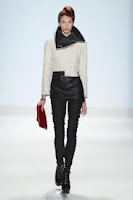Layering is something everyone talks about when the weather gets colder, and some nail it, and some don't. Wardrobe Consulting is here to help. With the recent low temperatures here in NC, the flooding in NJ from the hurricane, and snow in the Rockies, it's a good time to discuss how to layer so you're not too hot and not too cold.
Everyone knows that coming in from hot weather to cold air conditioned air is something we just have to deal with in the summer. It works that way in winter, as well. We come in from the cold to the nice warm heat, and in some offices the heat is dry and too hot. The solution required for the winter months are layers that stand on their own, which is tough to do with ultra-light fabrics that gape and hug in some interesting places, but provide warmth.
When thinking about what you are layering, start with the foundation garments. If the bra strap is going to hang out, maybe that bra you're thinking you might need to replace isn't the best one to wear that day. If you are thinking colored tights, like your favorite ones with the tiny little hole on the calf, they may not be your best bet if you are not wearing boots or something that will cover what will eventually become a bigger hole. While we're on the topic of colored tights - if they have stretched so much that the coloration looks different in some visible places, it's time to think about getting some new ones. I know they are hard to shop for and it's hard to find a pair that fit just right, are the perfect color and aren't too binding, but when layering, it's crucial to have foundation items that look right no matter what you layer over top of them. For guys, the raggedy, beat up Fruit of the Loom undershirt you love, you know, the one with the frayed collar that everyone will see, is probably a great candidate for replacement in this case.
If necessary, think about what you are wearing as your base layer to think about your foundation garments. Your base layer is the fashion forward outfit you can strip down to if the temperature turns out to be blazing hot in your office, the doctor's office or when you come into a house heated to 70 degrees when it's 30 degrees outside. The temperature change is likely welcome, but sooner or later, you'll want to start taking layers off so you don't sweat. This should be a fairly lightweight layer, things like a light cotton sweater with quarter length sleeves, or for guys, a short-sleeved polo or a button down with sleeves you can roll up.
When we talk about layering, it's mostly about keeping your upper body warm. Layering your lower body just doesn't really work unless you're planning on wearing long johns or some other kind of figure hugging legging to retain warmth. If you do happen to live in a cold weather environment where long johns are required to ward off frostbite, make sure they fit correctly. Having something that bunches and gathers under your pants or skirts will make you look bulky and likely cause discomfort.
The rest of the top layers should be easier. A sweater for guys, or a nice tweed jacket, and then an overcoat, like a nice trench. For women it becomes a lot about balance. Some women like to layer so the longest layer is the foundation layer, creating a visual rise with each layer. Some women like to layer so the longest layer is the first one removed, creating a different look with the removal of each layer.
Some final tips:
- If you worry about any problem areas, choose fitted clothing and not tight clothing. Tight clothing, even under layers, highlights problem areas or creates new ones.
- Wear your slimmer clothes underneath. For instance, a fitted shirt layered under a loose cardigan made of a lightweight wool or cashmere, layered under a lab or tweed jacket. Then a longer pea coat or trench to wear outdoors.
- Fluffy and bulky do not layer well. Anything that looks like it adds weight to your frame probably doesn't need to be layered except in a minimalist way, like a performance shirt designed for warmth underneath.
- Remember your colors - not too matchy-matchy. Layering colors that match tend to make the layers disappear.
- Use belts, scarves and other accessories to add dimension to your layers. Don't go overboard, though. There's no need to look like you wore everything in your closet that day - just add a couple simple touches to finish the look.
Do you have layering tips? I'd love to hear them!






























